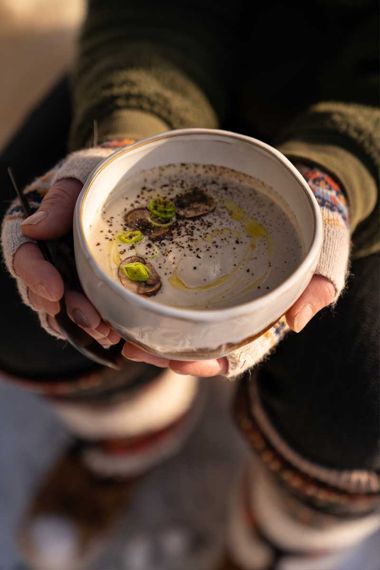Creamy Mushroom and Leek Soup
- Servings4

Full flavoured yet easy to make, this simple but refined soup is cozy and rich in earthy mushroom flavours and cashew creaminess. It’s a plant-based spinoff of an age-old family favourite that is sure to please!
Fungi family relations
Did you know that a portobello mushroom was once a white button mushroom, and that a white button mushroom turns into a cremini mushroom? They’re all the same, and part of the Agaricus bispourus fungi family!
This edible mushroom, in its immature form, is white and often referred to as a button mushroom. When it ages and darkens in colour, it becomes known as a cremini or baby bella. Once the mushroom matures and the cap widens and dries out, you can find them described as portobellos.
Creamy Mushroom and Leek Soup
- Servings4
Ingredients
- 1 cup (250 mL) raw cashews
- 2 cups (500 mL) boiling water
- 2 Tbsp (30 mL) avocado oil
- 1 medium-size leek, chopped (white and light green parts only)
- 1 yellow onion, diced
- 2 garlic cloves, peeled and crushed
- 8 cremini mushrooms, sliced
- 1 tsp (5 mL) sherry vinegar
- 3 cups (750 mL) mushroom broth
- 2 fresh thyme sprigs
- 1/2 tsp (2 mL) sea salt
- 1/4 tsp (1 mL) ground black pepper
Nutrition
Per serving:
- calories275
- protein11 g
- total fat17 g
- sat. fat3 g
- total carbohydrates24 g
- sugar6 g
- fibre2 g
- sodium440 mg
Directions
01
In small bowl, place raw cashews and add 2 cups (500 mL) boiling water. Let soak while preparing soup.
02
In large soup pot on medium, heat avocado oil. Add leeks and onions and sauté for 5 minutes, until onions are translucent. Add garlic and sliced mushrooms and sauté for a further 5 minutes, then add sherry vinegar, broth, and thyme sprigs. Bring soup to a boil, then reduce to a simmer for 10 minutes.
03
Remove pot from heat and discard thyme sprigs. With immersion blender, blend mushroom broth mixture well. Alternately, ladle all into blender and blend until smooth before returning to soup pot.
04
Drain water from cashews and add cashews to high-speed blender. Add 1 1/2 cups (350 mL) blended mushroom mixture to cashews and blend to create smooth cashew cream. Slowly whisk cashew cream back into remaining mushroom mixture in soup pot and bring to desired temperature. Enjoy!





